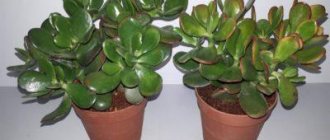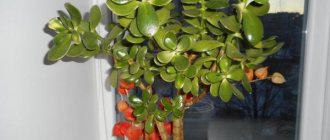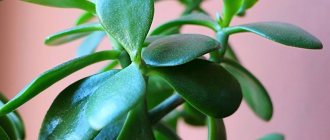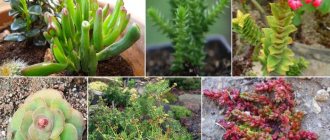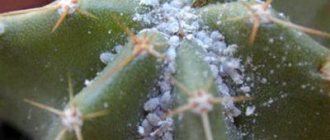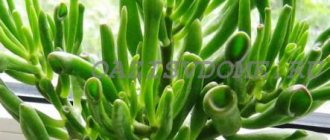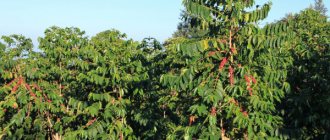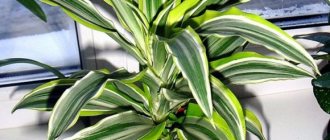There is a sign that the money tree reacts to the energy in the room. A plant that is poorly cared for has a negative impact on the health of its owner and his financial stability. A flowering tree is a sign of wealth and well-being in the family. Competent and timely care is important for the normal development of culture.
Name and botanical description
A succulent from the Crassulaceae family is called a money tree. Its Latin name is Crassula.
In everyday life, the house flower was given other names:
- penny tree;
- Crassula;
- coin tree;
- dollar tree (although this name is more typical for Zamioculcas);
- bear ear;
- the tree of Life;
- tree of luck.
This succulent is native to South Africa. There are many types and varieties of plants that differ greatly in appearance.
At home, the tree-like crassula is most often bred, which was given the name money tree for the shape of its leaves.
Tree Crassula looks like a tree with a thick gray-green trunk. As the succulent plant matures, the trunk becomes woody.
Money tree leaves are dark green or silver. The plates may have a red edge and are sometimes covered in spots. The surface of the leaves is glossy. They are shaped like coins. The size of one sheet is 4-7 cm.
The money tree indoor plant can reach 1.5 m. If desired, it can be trimmed so that the height does not exceed 50 cm.
Crassula is a slow-growing succulent. It reaches its maximum size only in the tenth year of life.
Popular varieties of tree crassula:
- Ovata;
- Purslane;
- Silver;
- Minor.
Also at home you can find columnar and ground cover (creeping) species of representatives of the Tolstyankov family. The first of them includes such a variety as Plaunovidnaya, the second - Perforata.
Main types of Crassula
According to various sources, there are up to 500 species of Crassula. Among the representatives of the genus there are herbaceous (among them there are creeping and hanging forms), bushy and tree-like, as well as aquatic (Helms's Crassula) plants.
In the wild, money trees can be seen in the Southern Hemisphere, especially in Africa and Madagascar.
All Crassulas existing in nature can be divided into 3 groups:
- erect (oval, purslane, tree-like, silver);
- creeping, or ground cover (moss-moss, pseudo-moss, milky, dotted, sucker, tetrahedral);
- columnar, or spicate (perforata, buddha, grouped, rocky, Cooper, Deceptor, Monstrosa).
Let's look at the photos and descriptions of the most common types found in apartments.
Ovate, oval, or ovoid
It is this fat plant that gardeners most often grow. In African savannas, money trees can reach 3 meters in height. At home, the size of the bushes is more modest - up to 1.5 meters.
The leaves are colored greenish or grayish-silver. The plant grows quite quickly, forming many shoots. The flowers are white or pink.
Oval Crassula is the most shade-tolerant - it feels great in significant shade. At the same time, she is not afraid of the bright sun.
Breeders based on the ovoid Crassula have created several varieties of the plant.
Sunset
A distinctive feature is the tricolor leaves: white or yellow stripes run through the green blades, with a clearly visible red border along the edge.
Minor
A compact bush with pale red leaves, which is an ideal choice for a mini-garden.
Gollum and the Hobbit
These are hybrids of oval and milk crassula. A feature of both varieties is the original tube-shaped leaves, as if turned outward. In Gollum they expand like a funnel towards the ends, while in the Hobbit they are fused from the base to the middle.
Crassula the Hobbit can be shaped into a bonsai.
Tree-like
This species is almost no different in appearance from the ovoid carassa, but, unlike it, it requires bright lighting and does not tolerate shadows. The leaves are grayish with a bluish tint and a reddish edge. The flowers are white or pink, but they appear extremely rarely in indoor conditions.
Several varieties of tree crassula are known.
Undulatifolia
The bluish-silver narrow leaf blades have red tips. There is a form with variegated leaves.
Curly
A characteristic feature is large wavy leaves.
Purslane or silver
In appearance, the purslane crassula closely resembles the ovoid and tree-shaped one, but it is more compact.
Mossy or mossy
A small shrub with creeping tetrahedral stems, the maximum height of which is 25 centimeters. The structure of the leaves is similar to the club moss, which is why it got its name. Completely undemanding to care, thrives in the shade. In bright light, the leaves take on a reddish tint.
Pseudoplauniform
It resembles a lycopod, but its stems are more curved. There are forms with yellow, silver and variegated foliage.
Lactea, or milky
An ampelous plant with shoots growing up to 30 centimeters in length. The leaves are grayish-green, rounded.
Spot
It has a very attractive and unique appearance. A characteristic feature is lodging stems covered with original leaves: red dots are “scattered” over the green background (they appear purple on the underside), the edge is covered with transparent cilia.
Perforated, or perforated
Low compact plant. A distinctive feature is the diamond-shaped leaves that are “strung” on the stem. The green leaf blade is covered with a bluish coating and has a reddish border.
Money tree: how to properly care for it at home
Caring for a money tree at home includes compliance with the plant’s requirements for light, frequency of watering and fertilizing.
Location and lighting
The best place to grow a money tree is on the windowsill of a south-facing window. South-west and south-east directions are also suitable.
Crassula is photophilous. But varieties whose leaves are purely green may suffer from direct sunlight. Therefore, at noon such plants are shaded.
Signs of sunburn are the appearance of a red border around the edges and brown spots in the center of the leaf.
Variegated and flowering varieties are especially sensitive to lack of lighting. A signal that the money tree does not have enough light will be:
- loss of decorative color by leaves;
- lack of flowering in a plant that previously produced buds regularly;
- elongated shoots, uneven crown;
- thinning and falling leaves.
If there is a lack of natural light, the money tree is illuminated with lamps.
Expert tip: “Regularly turn the money tree pot so that it faces the light. Otherwise, it will not be possible to form a symmetrical crown.”
Fresh air is important for the fat woman, but drafts are contraindicated for her.
If the plant is placed on a windowsill in winter, make sure that the leaves do not touch the glass.
Temperature
In summer, room conditions are optimal for tree-like crassulas - 24-28°C. The money tree loves differences between day and night temperatures.
If in the summer the room is hotter than 30°C for a long time, it is necessary to increase the frequency of watering.
During the dormant period, which lasts from late November to early February, the money tree needs coolness. It is better to keep it at a temperature of 14-16°C. For example, a pot of crassula can be placed on a glassed-in loggia.
The main conditions are that the temperature should not fall below 8°C, and the fat plant should be protected from drafts.
If the money tree is not kept cool over the winter, it may lose its leaves.
| Period | Optimal temperature, °C | Limit temperature, °C |
| Summer | 25 | 30 |
| Winter | 15 | 8 |
Watering
Rules for caring for a money tree at home include 3 recommendations for watering:
- In summer, water Crassula abundantly, but not more often than once every 14 days.
- In autumn and spring, reduce the frequency of watering to once a month.
- During the dormant period, water the plant only after the soil has completely dried.
Water is poured slowly, trying to prevent the formation of puddles in the root zone.
Crassula, like all succulents, does not tolerate waterlogging. Therefore, water that has flowed out of the pot through the drainage holes must be drained.
Expert advice: “Don’t focus only on the top layer of soil. Do not water the fat plant until the substrate has dried 3-4 cm deep into the pot.”
A sign of insufficient watering will be wrinkled leaves. Excess moisture leads to rotting of roots, discoloration and falling of leaves.
Water the plant with filtered or settled water. It is advisable to do this in the evening.
Some gardeners use bottom watering for Crassula. They pour water into the pan and, if it is absorbed in less than 20 minutes, and the surface of the soil remains dry, they add more.
The video below provides recommendations for watering a money tree.
Air humidity
The fat woman does not like humid air. The money tree succulent does not need to be sprayed.
To remove dust, wipe the leaves of the plant with a damp cloth. You can wash Crassula in the shower, but you need to make sure that water does not get on the soil.
Crassula tolerates dry air well, even during the heating season. Its leaves have a sufficient supply of moisture so that unfavorable external conditions do not damage it.
If the pot with the money tree is in a room with high humidity, then the frequency of watering is reduced. In this situation, water the plant only if the leaves become soft or the soil is completely dry.
Top dressing
Caring for a money tree during the active growing season (from late May to mid-August) involves fertilizing. It will be enough to do this three times per season.
Store-bought fertilizers for cacti and succulents are recommended. Most of all, a money tree needs 3 elements:
- phosphorus;
- potassium;
- nitrogen.
But an excess of the second and third components also negatively affects the plant and causes the death of the roots.
Mineral fertilizers are taken with a concentration of 5:10:5, where the maximum dose is phosphorus.
It is preferable to use liquid fertilizers, which are applied after abundant watering. To dilute the dry composition, use settled water at room temperature.
Crassula only requires a quarter of the dose recommended for succulents.
Among organic fertilizers and “folk” recipes, the best option would be feeding with ash. It is poured onto the ground and buried a little deeper. A solution is also used: 200 g of ash is poured into a glass of water and infused for 7 days.
Bone and fish meal, and eggshells are suitable for fertilizing the money tree.
If an adult Crassula has been transplanted, it is not fertilized this year.
Find out how experts from the channel “Flowers in the House” recommend feeding the money tree. Houseplants”, you can see in the video below.
Where is the best place to put it in the house?
Each flower has its own criteria for development. The money tree will grow well if placed indoors under the following conditions:
- the room should have an average temperature, the plant should not feel heat or frost. It is worth cleaning regularly so that the leaves do not absorb dust;
- the flower cannot be placed next to the radiator as the fat plant does not like dry air. You can solve the problem using a humidifier. The plant will feel good next to an aquarium or swimming pool, or in the bathroom.
Taking into account the signs, it is best to place a plant such as a crassula or money tree in the area of financial well-being. To calculate it, you need to divide the room into 9 zones. You need to select the lower right corner in the resulting grid. You can install a plant in it to attract money into the house.
Note! For the fat woman's luck to work, the color of the walls in the room should not be scarlet. It is best to choose green or purple shades.
Formation of the Crassula crown
Caring for a money tree at home always includes pruning. If this is not done, the plant will be of irregular shape, with branches that are too long and break under their own weight.
They begin to give the crown the correct shape from the first days of life.
Principle of pruning the money tree:
- The lateral shoots of a young specimen are removed until the length of the bare trunk reaches 15 cm.
- When the total height of the crassula becomes 25-30 cm, cut off the crown under the two top leaves. This leads to the formation of side shoots.
- The cut is made at an angle of 45°. It is advisable to remove no more than ⅓ of the length of a healthy branch. If branches are removed completely, this should be done over brown rings (leaf scars).
- All cuts are sprinkled with crushed coal to protect the plant from infection.
- When the first shoots grow sufficiently, they are pinched (the top bud is removed) so that they also begin to branch. 4 pairs of leaves are left on each branch.
If, after pinching the shoot, not two lateral buds, but one, form on it, the procedure is repeated.
The described principle allows you to form a tree-like plant.
If a gardener wants to get a lush bush, he should not remove the side shoots of a young fat plant. But pinching will still be required. Otherwise, the cutting will grow without branching.
If you trim an adult plant, stumps will form in place of the removed branches. This procedure should be carried out in the spring in order to remove shoots and branches that have stretched out over the winter and grow inside the crown.
In the summer, only leaves that have begun to turn yellow or are out of shape are removed. In autumn and winter, the tree is not touched.
If signs of infection are detected, the damaged parts of the plant are cut off immediately, regardless of the time of year.
If it is necessary to rejuvenate the plant, total pruning is carried out, removing up to ¾ of the length of the shoots.
After pruning, as after transplantation, the money tree is kept in partial shade until it recovers from the procedure.
You can find out what mistakes gardeners most often make when forming the crown of a crassula from the video.
Plant structure
The money tree is slightly different in its structure from similar plants that are capable of storing large amounts of water in their tissues (succulents).
Roots
Most succulents have a fairly simple and shallow root system. The root is only one of many mechanisms for storing moisture, but not the most important of them.
In this regard, the root system of Crassula consists of a central rhizome, extending to a shallow depth, as well as numerous lateral shoots, most of which lie only 3-4 cm deep in the soil. In a number of species, aerial root shoots can be found.
Due to such underdevelopment of the root system, Crassula has difficulty surviving every transplant. However, this procedure cannot be avoided, because the flower grows quickly.
Another big problem is that the root system is not always able to firmly hold adult Crassulas, as they become large in size. Because of this, you should carefully select a flower pot: it must be strong, large and heavy.
Crassula root system
INTERESTING . The older the money tree, the more woody its main root becomes and the easier it is to survive transplants.
Leaves
Crassula foliage is the most important component of the plant, determining its identity . It is because of them that the flower largely received its more famous name - the money tree. They also serve as the plant’s most important tool for accumulating moisture, as well as useful micro- and macro-compounds in case of prolonged drought.
The leaves of Crassula are fleshy, dense, often small than vice versa. Most varieties cannot boast of large leaves (they reach only about 5 cm in length), but they always grow so tightly together that they form a neat and extremely attractive crown. Their surface is covered with a waxy coating.
The color of the foliage differs on the outside and back. Usually the inside is decorated with pinkish spots, which can even occupy the entire lower plate.
Crassula leaves
Important! An integral part of the beautiful and correct formation of the Crassula crown can be called pinching the shoots. In this case, the classic growth of the flower occurs in the form of a green dense ball.
Flowers
Flowering of Crassula indoors is a rather rare phenomenon, but it also happens. Most varieties bloom with soft white or light yellow flowers. However, the shades may be different, albeit in a few cases.
On the other hand, if flowering is achieved, then almost the entire crown of the plant is dotted with small single flowers (1-2 cm in diameter) or panicles of inflorescences.
One of the characteristic features of Crassula is its persistent, fragrant aromas when flowering.
The plant blooms for the first time late, usually not earlier than 10 years of age . But then flowers can appear every year (and with less frequency, but only if the flower is poorly cared for). The period of appearance of flowers occurs mainly in late autumn or winter, but it also happens in spring. If the plant is cool (not higher than +18С), then flowering can last up to 3 months in a row.
Money tree flowers
Fruit
The fruits of Crassula, in which the seeds ripen, are multileaflets (or collective leaflets). They are formed not in place of flowers and inflorescences, but in special formations on the stem. They are leathery, dry pericarps with seeds that ripen along the seam.
They are practically never found in captivity.
Money tree fruit
Crassula flowering
With proper care for the money tree, it can bloom at home. Basic requirements for the formation of buds:
- sufficient illumination all year round;
- cold winter;
- good feeding and frequent replanting.
No matter how much the owner cares for the money tree, only mature specimens, older than 10-15 years, are capable of blooming.
Money tree flowers are small, with white petals, star-shaped and emitting a strong aroma. Flowering lasts for 2-3 months and occurs in winter.
Expert advice: “Flower buds are formed on young shoots in the fall. If you want the money tree to bloom, you need to prune it in early spring and not disturb it again this year.”
Another important condition for flowering is a sufficient amount of fresh air. The money tree will not produce buds if it grows in a poorly ventilated area.
Transfer
Caring for a money tree necessarily includes timely replanting. Young specimens require it annually, adults - once every 2-3 years.
If a gardener wants the Crassula to stop growing, he may not replant it at all. It is enough to change the top layer of the substrate once a year.
To change the pot and renew the soil, Crassula is replanted at the end of March or in April.
The first transplant is done 2 weeks after purchase. It can be postponed for a longer period if the plant was purchased in winter.
Pot
Crassula has a heavy crown and a rather weak root system. The main requirement for a money tree pot is stability.
The container for transplanting the Crassula should be wide, but not high. It is advisable to use a clay pot because... it is heavier.
A prerequisite is the presence of drainage holes.
For only rooted cuttings, use bowls with a diameter of 5-7 cm. For a young plant, take a small pot, no more than 10 cm in height and 20 cm in diameter, so that the roots do not grow to the detriment of the above-ground part.
The diameter of a pot for an adult specimen should not exceed the size of the crown of a money tree.
The soil
The soil for the money tree is loose, easily permeable to water and air.
You can buy soil for succulents at flower shops. It is also suitable for fat women.
Recipe for making your own substrate:
- turf land;
- leaf soil;
- humus;
- gravel;
- coarse sand.
Take 3 parts of the first component, one part each of the rest. Gravel can be replaced with agroperlite. Some gardeners add ash to enrich the composition.
Before transplanting the plants, the soil is disinfected.
Step-by-step instructions for transplantation
Drainage (expanded clay, pebbles) mixed with charcoal or activated carbon is placed at the bottom of the pot. This prevents the soil from becoming waterlogged and reduces the risk of the plant becoming infected with fungal infections.
If the plant is mature, with a massive crown, stones, bricks, etc. are placed under the drainage to prevent the pot from tipping over. You can also use different supports.
Step-by-step instructions for replanting a money tree:
- Remove the flower from the old pot. To make this easier, transplantation is carried out the next day after watering.
- Examine the roots of the plant entwined in the earthen ball. If they are healthy, place the tree in a new pot without removing the old soil.
- If rotten areas are found, clean the roots from the soil and remove non-viable roots.
- Sprinkle the cut areas with charcoal and let them dry (2-3 hours is enough).
- Place the fat plant in a new pot with a layer of drainage and substrate.
- Cover the roots with soil. The root collar should not be buried. The soil level should be the same as in the old pot.
- Compact, but do not compact the substrate, water the plant.
- Place the pot in partial shade for a week. The room should be cool.
If an adult specimen with a large crown was transplanted, several stones are placed on top of the soil. They are removed when the root system has established itself in the new soil (after 7-14 days).
You can see how the fat plant is transplanted in the video below.
How to resuscitate?
The peculiarities of the “Money Tree” as a succulent plant allow you to avoid the death of damaged specimens.
When shedding leaves, loss of turgor, stretching of branches and other problems associated with improper care, it is enough to remove the damaged areas.
It is necessary to create comfortable conditions for the plant to return to its original appearance.
But when root rot is discovered on the Money Tree, drastic measures are required to revive it. Infected roots are removed from the plant, treated with an antiseptic and replanted in new soil. If all the roots are dead, then the top of the tree is cut off and rooted, as with cuttings. This is the only way to save the plant.
Money tree propagation
The money tree can be propagated vegetatively, but only leaves and cuttings are used for this. It is impossible to divide the Crassula bush. If you cut the root, the newly formed plants will not take root.
Cuttings or leaves
Only an adult plant that is more than 3 years old is cut. The best time for rooting is March-April.
For propagation, you cannot use old, yellowing or, conversely, too young leaves.
If propagation is carried out by cuttings, choose a healthy and well-developed shoot from the middle of the plant.
Its optimal length is 5-10 cm. The branch must have at least 3 pairs of leaves and 3 nodes. You can use shoots that have produced aerial roots.
Step-by-step instructions for cutting money trees:
- Cut the stem cutting below the node with a sharp knife. Sprinkle the cut areas with crushed activated carbon.
- Remove the lower leaves so that they do not end up under a layer of soil.
- Dry the cutting by letting it lie in the air until it loses turgor.
- Without rooting in water, immediately plant the cuttings in a mixture of peat and sand. Deepen it no more than 5 cm. The soil should be slightly moist.
- As it dries, moisten the substrate with a spray bottle.
- After waiting until the cutting begins to grow and the young specimen reaches 10 cm in height, transplant it into a pot.
Do not deepen the crassula too much. The soil should only cover the roots. The leaf is rooted using the same principle.
The optimal temperature for germination of cuttings is 20-22°C.
If the grower wants to observe the appearance of roots, rooting in water is acceptable. Activated carbon and stimulants (for example, Zircon) are added to the glass. The water is not changed, only added as it evaporates.
You can learn more about vegetative propagation of the money tree from the video.
Using seeds
This is a rather rare and time-consuming way to propagate a money tree. Only experienced flower growers resort to it.
The best time to plant seeds is February.
Step-by-step instructions on how to grow a money tree from seeds:
- Cover the bottom of the container with drainage and cover it with substrate. Usually a mixture of two parts leaf soil and one part sand is used.
- Place the seeds and deepen them a little.
- Close the container and place in a warm (22-25°C) and bright place.
- Every day, ventilate the greenhouse for about an hour, make sure that the soil does not dry out, and if necessary, moisten it with a spray bottle.
- After the first shoots appear, remove the lid completely.
- After about a month, transplant the seedlings into a larger container.
The seedling is placed in the pot when it reaches 6-7 cm in height. The young fat plant is protected from direct sunlight and watered carefully.
In the first year of life, the succulent does not have a cool winter. The plant is not yet strong enough for this.
Diseases and pests
Crassula can be affected by a fungal infection, gray rot. Development is promoted by regular overwatering of the plant and lack of fresh air in the apartment.
Several types of pests can parasitize the money tree.
| Parasite | Signs | Fighting methods |
| Shchitovka | Brown or yellowish bumps on leaves | soap solution (Fitoverm) |
| Spider mite | Web between leaves and stem | The pest is removed with a swab soaked in alcohol. The plant is treated with insectoacaricides or acaricides |
| Aphid | Yellowish spots on the leaves. Insect colonies on the bottom of the plates | Treatment with soap solution and insecticides |
| Mealybug | Plaque in the leaf axils | Bathing the plant in the shower and using insecticides |
The appearance of parasites indicates that the plant is kept in extremely unsuitable conditions.
Common mistakes and problems in growing
The money tree rarely gets sick or is attacked by pests. More often, the loss of decorativeness is associated solely with errors in care. The main ones are given in the table.
| Problem | Probable Cause |
| Thinning leaves | Overwatering |
| Falling leaves in winter | Room too warm |
| Fall of leaves in spring and autumn | Excess fertilizer. Watering with cold water. Excess moisture. Root rotting |
| Root rotting | Excess moisture, especially during the dormant period when kept in a cool room. |
| Yellowing of leaves | Lack of lighting |
| Wilting of leaves. Light or black spots on the plates | Sunburn |
| Dry reddish crust on leaves | Soil depletion. Stagnant air in the room. Sunburn |
| Dry brown spots on leaves Loss of turgor | Lack of moisture |
| White dots on leaves | Excess moisture |
| Darkening of the trunk | Excess moisture |
| The trunk has become soft | Lack of light. Excess moisture. Heat |
Since the money tree is considered an unpretentious plant, it is often planted by inexperienced gardeners.
No matter how hardy it is, the owner’s mistakes affect the condition of the Crassula. Because of them, it loses its decorative effect and sometimes dies.
The consequences of most of them are solved by changes in care. Overwatering can cause root rot and death of the money tree.
Benefits and harms
It is believed that the phytoncides secreted by the leaves of the fat plant are capable of disinfecting the air. And its juice is credited with the ability to help with a variety of problems, including:
- inflammation of the gums;
- insect bites;
- calluses, etc.
Anyone who decides to try traditional medicine recipes must remember that Crassula is a poisonous plant. Its juice can only be used externally.
Crassula leaves are capable of accumulating arsenic.
Plants that are grown in arsenic-free soils are considered safe.
But still, the home money tree should be kept out of the reach of animals and small children and caution should be exercised when using popular advice.
Introduction
Crassula, or money tree, is grown by almost all lovers of indoor floriculture.
For some, this plant is in the form of a shapeless bush with shiny leaves, for others, it is a spreading tree of an original shape. But this is not the limit of the decorative possibilities of the fat woman.
Knowing all its features, you can create elegant compositions in the oriental style and even take a swing at bonsai, which, according to oriental metaphysics, increases prosperity and happiness.
Signs and beliefs
If a person believes that a money tree will bring him prosperity, he should know well how to care for it.
According to the superstition, only a healthy Crassula will be the key to wealth. A sick fat woman attracts financial failures.
Also, to increase wealth, follow 3 rules:
- Crassula cuttings are asked from relatives or close friends and grown into an adult tree on their own;
- Coins are buried in a pot with a money tree, they are placed on the bottom with the coat of arms facing up;
- Crassula branches are decorated with coins, which are hung on red cords.
According to Feng Shui, the money tree is placed in the wealth zone, in the southeastern part of the apartment.
There is also a belief that the fat woman is an indicator of the atmosphere in the family. No matter how properly the money tree is cared for, it will wither if the owners constantly quarrel or if a seriously ill person lives in the house.
At the same time, many Crassula owners believe that it is able to smooth out a negative environment and fill the house with positive energy.
Several folk signs for the money tree:
- Crassula flowering is a signal of a quick increase in family income;
- give or throw away the fatty - lose money;
- the plant loses leaves - to the collapse of the business;
- a pot with a money tree fell - to a loss.
You can learn more about the signs and superstitions associated with the money tree from the video.
Answers to popular questions
How long does the fat woman live?
The average lifespan of one specimen is 20-30 years. With proper care, a money tree can live up to 50 years.
Is it possible to save a tree that has lost its decorative properties?
If the fat plant has shed its leaves due to a too warm winter, it will produce new shoots from which a new crown can be formed. If the reason for the loss of decorativeness is rotting and death of the roots, you need to grow a new specimen by cuttings.
Is it possible to leave the plant without care during the holidays?
Crassula can live for a month without watering, even in summer. Before leaving, water the money tree more abundantly than usual, mulch the soil, and place the pot in the shade.
Why can’t I form a round crown?
If the money tree is bent and stretched, this is a sign of lack of light.
Why doesn't the money tree grow?
There can be many reasons for this situation, from an unsuitable pot and improper watering to rotting roots and pest infestation. You need to replant the plant, make sure the roots are healthy, and use enough drainage. It is also necessary to adjust the watering regime. Stunting of growth is normal if it occurs in winter.
Why do Crassula cuttings not take root?
If rooting is carried out at the right time of year, then the main reason for the mass death of cuttings is their insufficient drying. In order for a Crassula leaf or twig to produce roots, they must be well “withered.” The cutting is ready for rooting when it has lost its shine and turgor and has become wrinkled.
Why isn't it growing?
Slowing the growth of the money tree is not always abnormal. It happens that this plant stops development for completely natural reasons.
Natural factors
There are periods in the life of a money tree when it slows down its growth for reasons related to the characteristics of its growing season.
In these cases, no emergency measures need to be taken. Reasons for natural growth slowdown:
- Adaptation to new conditions. This phenomenon is observed when moving the pot from place to place, when moving it to another room, or when temperature and humidity conditions change.
- Transplant into a new pot. As a rule, addiction does not last long; the crassula soon begins to grow again.
- Seasonality. In the autumn-winter period, the money tree slows down its growth even in high temperatures (in winter it is recommended to keep the plant at + 15 ° C), as dormancy begins.
- Reproduction method. A seedling grown from a leaf (baby) initially grows much slower than a rooted cutting.
- Bloom. The money tree rarely blooms, and when it does, the plant takes a long time to recover. Crassula usually does not grow after flowering for several months.
- Variety The speed at which a money tree grows depends on its variety. Compact varieties grow much slower than the species plant.
Incorrect landing
One of the most common reasons for slow growth associated with agricultural technology is violation of planting rules.
Mistakes when planting Crassula:
- Pot too big. The plant has a superficial root system (fibrous type). Root shoots do not grow to the size of the crown projection. The roots entwine the soil lump for a long time, and only then does growth begin. If the container is too large, the succulent either does not grow or dies due to acidified soil.
- There is no drainage. If the pot does not have drainage holes and/or a drainage layer, irrigation water will accumulate at the bottom, preventing the substrate from drying out. Due to stagnation of water, the roots begin to rot. And even if the soil does not turn sour, the plant does not increase in size.
- Unsuitable soil. Crassula is demanding on the composition and acidity of the soil. It needs a loose, light, low-nutrient substrate with neutral or weak acidity. If you plant it in heavy or acidified soil, it will not only not grow, but will also begin to wither, even to the point of death.
- Injury to roots. If the grower was not careful enough during transplantation, as a result of which the roots were damaged, the fat plant will take a long time to recover. During this period, the tree slows down its growth.
